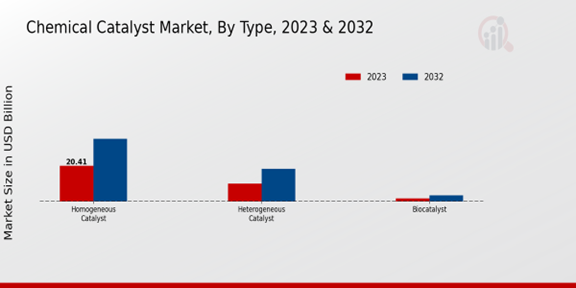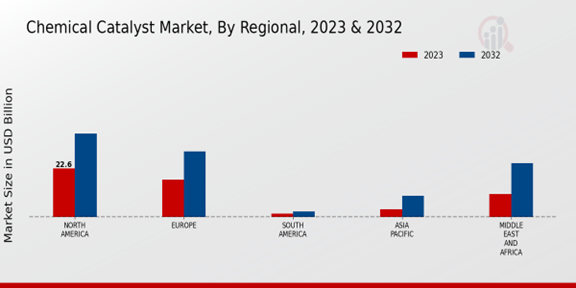Key market drivers for the chemical catalyst market include rising demand for refined petroleum products, growing chemical production, and increasing environmental regulations. The market is also benefiting from technological advancements in catalyst development and the development of new, highly efficient catalysts.Opportunities for exploration and capture in the chemical catalyst market include the development of catalysts for emerging applications such as biofuel production and carbon capture and utilization.
The market is also expected to benefit from the growing demand for catalysts in emerging economies, particularly in Asia-Pacific.Recent trends in the chemical catalyst market include the development of more sustainable catalysts, the use of nanotechnology to improve catalyst performance, and the integration of catalysts into chemical processes to improve efficiency and reduce costs. The market is also seeing a growing demand for specialized catalysts for specific applications, such as catalysts for the production of pharmaceuticals and fine chemicals.
Chemical Catalyst Market Type Insights
The Chemical Catalyst Market is segmented by Type into Homogeneous Catalyst, Heterogeneous Catalyst, and Biocatalyst. Among these, the Homogeneous Catalyst segment held the largest market share in 2023, accounting for over 40% of the revenue. This dominance is attributed to the high activity and selectivity of homogeneous catalysts, making them ideal for various chemical reactions, including hydroformylation, hydrogenation, and oxidation. The Heterogeneous Catalyst segment is projected to witness the fastest growth during the forecast period, with a CAGR of over 7%.The increasing demand for heterogeneous catalysts in the refining and petrochemical industries is driving this growth.
Heterogeneous catalysts offer advantages such as ease of separation from the reaction mixture and reusability, making them cost-effective options for large-scale chemical processes. Biocatalysts, derived from biological sources such as enzymes and microorganisms, are gaining traction due to their high specificity and environmentally friendly nature. The growing demand for sustainable and eco-friendly chemical processes is expected to fuel the growth of the Biocatalyst segment in the coming years.Overall, the Chemical Catalyst Market is poised for significant growth in the coming years, driven by the increasing demand for catalysts in various industries, including chemicals, pharmaceuticals, and energy.
The ongoing advancements in catalyst technology and the development of novel catalysts with enhanced performance and efficiency are expected to further drive market growth.
 Source: Primary Research, Secondary Research, Market Research Future Database and Analyst Review
Source: Primary Research, Secondary Research, Market Research Future Database and Analyst Review
Chemical Catalyst Market Application Insights
The application segment plays a crucial role in shaping the Chemical Catalyst Market. Petroleum Refining is projected to hold the largest market share due to the increasing demand for refined petroleum products. Petrochemical Production is expected to witness significant growth owing to the rising need for plastics and other petrochemical-based products. Polymerization is another key application segment, driven by the growing demand for polymers in various industries such as automotive, packaging, and construction.
Pharmaceutical Production is anticipated to contribute a substantial share to the market as the demand for pharmaceuticals continues to rise globally.Fine chemical synthesis is also expected to experience notable growth due to the increasing demand for fine chemicals in various industries, including pharmaceuticals, cosmetics, and food.
Chemical Catalyst Market Base Material Insights
Base materials play a crucial role in the production of chemical catalysts, influencing their properties and applications. Metals, a key base material, are characterized by high thermal stability and resistance to corrosion. They are commonly used in catalysts for reactions involving hydrogenation, dehydrogenation, and isomerization. Metal oxides, another important base material, offer high surface area and catalytic activity. They are widely employed in catalysts for oxidation, reduction, and dehydrogenation reactions. Zeolites, a type of microporous material, are known for their high selectivity and shape selectivity.They are used in catalysts for cracking, isomerization, and alkylation reactions.
Clays, a naturally occurring material, are used as a support for catalysts due to their high surface area and ability to control catalyst dispersion. The choice of base material depends on the specific requirements of the catalytic process, such as reaction conditions, desired product selectivity, and catalyst stability. By understanding the properties and applications of different base materials, manufacturers can optimize catalyst performance and meet the evolving demands of the chemical industry.
Chemical Catalyst Market Performance Insights
The Performance segment plays a crucial role in the Chemical Catalyst Market, accounting for a significant share of the overall market revenue. The segment encompasses various attributes that influence the performance of catalysts, including Activity, Selectivity, Stability, and Recyclability. Activity refers to the rate at which a catalyst accelerates a chemical reaction, which is critical for optimizing process efficiency. Higher activity enables faster reactions and increased production rates. Selectivity measures the catalyst's ability to promote specific reactions while minimizing unwanted side reactions.This aspect is vital for producing high-purity products and reducing waste.
Stability indicates the catalyst's resistance to degradation under operating conditions. Stable catalysts maintain their activity and selectivity over extended periods, reducing the need for frequent replacements and downtime. Recyclability involves the ability to recover and reuse catalysts after their initial use. This feature contributes to cost savings, environmental sustainability, and the circular economy. Advancements in catalyst technology have led to the development of highly active, selective, stable, and recyclable catalysts, driving the growth of the Performance segment.These catalysts enable efficient and cost-effective chemical processes, supporting industries such as petrochemicals, pharmaceuticals, and renewable energy.
Chemical Catalyst Market Regional Insights
The Chemical Catalyst Market is expected to reach a value of 35.25 Billion USD in 2023, with a growth rate of 7% from 2023 to 2032. Regionally, North America holds the largest market share, followed by Europe and APAC. North America is projected to continue its dominance over the forecast period due to factors such as the presence of major chemical and petrochemical industries, stringent environmental regulations, and increasing demand for high-performance catalysts.
Europe is another significant market for chemical catalysts, with a strong presence in the automotive, pharmaceutical, and chemical industries.APAC is expected to witness significant growth in the coming years due to rapid industrialization, growing demand for consumer products, and government initiatives to promote sustainable manufacturing practices. South America and MEA represent emerging markets for chemical catalysts, with increasing demand from the oil and gas, refining, and petrochemical sectors.
 Source: Primary Research, Secondary Research, Market Research Future Database and Analyst Review Chemical Catalyst Market Key Players And Competitive Insights
Source: Primary Research, Secondary Research, Market Research Future Database and Analyst Review Chemical Catalyst Market Key Players And Competitive Insights
Major players in Chemical Catalyst Market industry are constantly striving to innovate and develop new and improved products to cater to the evolving needs of end-users. Leading Chemical Catalyst Market players are investing heavily in research and development to enhance the efficiency and selectivity of their catalysts. The Chemical Catalyst Market industry is characterized by a high degree of competition, with several prominent players vying for market share. Strategic alliances and partnerships are common in the industry as companies seek to gain access to new technologies and expand their product portfolios.
The Chemical Catalyst Market industry is also witnessing a trend towards consolidation, with larger players acquiring smaller firms to strengthen their positions.BASF, a leading player in the Chemical Catalyst Market, offers a wide range of catalysts for various applications, including petrochemicals, refining, and emissions control. The company's commitment to innovation and customer service has helped it maintain a strong position in the market.
BASF's focus on sustainability and its efforts to develop environmentally friendly catalysts are also contributing to its success.Johnson Matthey, another major player in the Chemical Catalyst Market, is known for its expertise in automotive catalysts and emission control technologies. The company's research and development efforts are focused on developing innovative solutions to meet the increasingly stringent emission regulations. Johnson Matthey's presence and strong customer relationships have enabled it to capture a significant market share.
Key Companies in the Chemical Catalyst Market Include
- LyondellBasell Industries N.V.
- Sumitomo Chemical Co., Ltd.
- Clariant International Ltd.
Chemical Catalyst Market Industry Developments
The market growth is attributed to the increasing demand for catalysts in various industries, including chemicals, petrochemicals, and pharmaceuticals.
Furthermore, government regulations promoting sustainable production processes and emission reduction targets are expected to drive the adoption of chemical catalysts.Key recent developments in the market include:- BASF's investment in a new catalyst production facility in China to meet the growing demand for catalysts in the Asia-Pacific region.- Johnson Matthey's acquisition of CRI Catalyst Company to strengthen its position in the automotive catalyst market.- Evonik's launch of a new catalyst technology for the production of biofuels, supporting the transition to renewable energy sources.
Chemical Catalyst Market Segmentation Insights






 Source: Primary Research, Secondary Research, Market Research Future Database and Analyst Review
Source: Primary Research, Secondary Research, Market Research Future Database and Analyst Review  Source: Primary Research, Secondary Research, Market Research Future Database and Analyst Review Chemical Catalyst Market Key Players And Competitive Insights
Source: Primary Research, Secondary Research, Market Research Future Database and Analyst Review Chemical Catalyst Market Key Players And Competitive Insights







